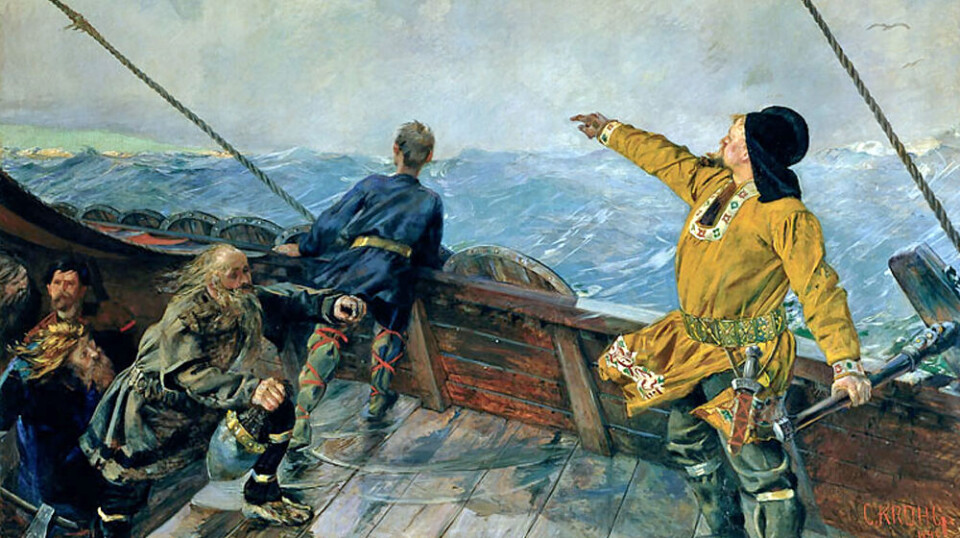THIS CONTENT IS BROUGHT TO YOU BY University of Oslo - read more

This painting of Leif Eriksson was never considered controversial nor important – until last year
The painting Leiv Eiriksson Discovering America has surprisingly become a significant work in Norwegian art history, according to art historian.
In March 2023, Christian Krohg and his painting of Leif Eiriksson were on everyone's lips in Norway. Was it colonialist? Did it deserve a place in the exhibitions at the National Museum of Norway?
One of those who participated in the debate was Øystein Sjåstad, professor of art history at the University of Oslo.
“For me, this became a canonisation process minute by minute,” Sjåstad says when he looks back on the commotion in newspaper columns and social media.
According to the Great Norwegian Encyclopedia, a canon is a selection of works that have been considered as typical and influential over time. There is no official list, and Sjåstad is not out to make one.
“I want to understand the mechanisms behind it. A canon is always in motion, but there are some artists and some works that are defined as very typical for a particular period and that are considered to be particularly influential,” Sjåstad says.
Leiv Eiriksson Discovering America did not have such status before the painting suddenly came into the spotlight when it became known that the National Museum in Norway's capital Oslo did not wish to display it as part of its permanent exhibition.
“The Leif Eiriksson painting has never been seen as a particularly important work of art. Until now,” Sjåstad says.
Discovers or arrives – what to name the artwork?
When the debate started, Øystein Sjåstad was more qualified than most to have an opinion on this particular artwork. He was already well into writing a book where the painting plays a central role.
Soon he will publish a biography of the artwork in the anthology (Post)Colonial Norway. The book is connected to a research project in which Sjåstad is participating.
First, there needs to be an agreement on what to call the painting. Sjåstad believes Leiv Eiriksson Arrives in America is a better name, and not just because the word discovering can be perceived as colonialist.
“The artwork operates with two titles. The first I have found is Leiv Eiriksson Arrives in America. When Krohg exhibited the work for the first time, it was arrives that was used,” Sjåstad says.
Discovering only emerged a bit later in the painting's convoluted journey.

A rival to Columbus
It all started on the other side of the Atlantic.
The World's Fair in Chicago in 1893 was to celebrate the 400th anniversary of Christopher Columbus arriving in America, but influential Norwegian Americans wanted to tell a different story.
“In the USA, there were organisations that had already started erecting statues of Leif Eiriksson. At the World’s Fair, they wanted to promote Leif Eiriksson as an alternative to Columbus, as Columbus represented Italian Americans,” Sjåstad says.
Therefore, a competition was announced in Norway, for Norwegian artists. Even then, there was commotion that resembled the heated discussions of 2023.
Many said that the chairman of the jury was too traditional. He resigned, and more radical forces took over. This paved the way for Christian Krohg's victory.
Too modern
The painting and all the sketches were exhibited in Kristiania (now Oslo) and received great reviews. It was expected that this painting would impress in Chicago.
But it did not turn out that way.

“When the committee in Chicago opened the package and saw the painting, they thought it was absolutely terrible. It was far too modern,” Sjåstad says.
They didn't like the French-inspired impasto painting. They did not appreciate that the figures in the painting looked tired and worn out; they wanted proud, robust, and heroic Vikings.
Returned to sender
After some modest years in the USA, the painting returned to Norway and the National Gallery in 1900.
Leif Eiriksson organisations covered the shipping costs. The Norwegian welcome was not overly enthusiastic.
“What happens next is a bit uncertain, but in 1907, at least, it was hung in a stairwell in the newly built side wing of the National Gallery. Not inside the actual gallery, but in the staircase with several other large paintings that they didn't know where to store,” Sjåstad says.
Later, it went to the World's Fair in Rio de Janeiro before gaining prominence when Nazi Germany occupied Norway during World War II.
A major Nazi hero
“Leif Eiriksson was a great Nazi hero and a role model. They fell in love with the painting and hung it in what they called the Führer's Hall in the National Gallery,” Sjåstad says.
After the war, it returned to obscurity and eventually a long stay at the Maritime Museum in Oslo. In 2002, it was brought back to the National Gallery in connection with the 150th anniversary of Krohg's birth.
“It was hung in the staircase where many believe it has always hung,” he says.
Still, its existence was turbulent, dependent on the preferences of different museum directors. When the new National Museum was built, the painting was placed in storage.
“Then, it was displayed for three weeks last year,” Sjåstad says.
A colonialist painting
Sjåstad does not want to express an opinion on whether the artwork should be displayed as part of the permanent exhibitions at the National Museum. However, he believes that it deserves careful consideration.
“In future plans for the core exhibition, it will be difficult to avoid discussing whether it should be shown again. And whether it can be done in a good way,” he says.
He is in no doubt that it is correct to label the work as colonialist, independently of the fact that Christian Krohg was really just after the prize money and considered the whole competition rather silly.
“I don't mean that the painting itself is colonialist or racist, but the history and usage will still be there. Leif Eiriksson was just meant to play the role of a Columbus alternative, as the kind colonialist, in a way. But he is part of a colonialist debate among Norwegian Americans who at the time completely ignored the Native American population and African American. Giving the work a different title will not change that fact,” Sjåstad says.
It is primarily the work's history that makes him believe the painting has now been canonised. But what about the quality? Is the work good or bad?
“I get that question a lot. I usually answer that I am not an art critic. I am an art historian who tries to understand the painting. Besides, I have become such good friends with the painting that I can't judge it as ugly or beautiful, bad or good,” Sjåstad says.

This content is paid for and presented by the University of Oslo
This content is created by the University of Oslo's communication staff, who use this platform to communicate science and share results from research with the public. The University of Oslo is one of more than 80 owners of ScienceNorway.no. Read more here.
More content from the University of Oslo:
-
Putin’s dream of the perfect family
-
How international standards are transforming the world
-
A researcher has listened to 480 versions of Hitler's favourite music. This is what he found
-
Researcher: "AI weakens our judgement"
-
New, worrying trend among incels, according to researcher
-
Ship’s logs have shaped our understanding of the sea




































